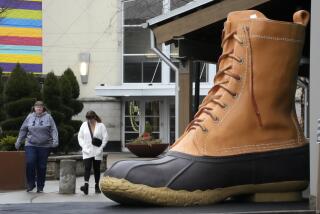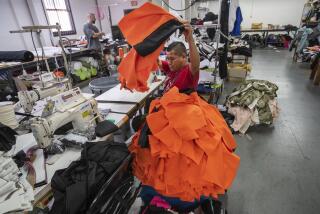Business Inventories Increase 0.4% in January : Economists See Figure as Sign That Downturn May Be Avoided in Early ’88
- Share via
WASHINGTON — Business inventories rose 0.4% in January, less than half the increase of the previous month, as a rebound in car sales helped to reduce a huge backlog of unsold cars, the government reported Monday.
The Commerce Department said inventories increased by $3 billion in January, pushing the total of unsold items on store shelves and back lots to a seasonally adjusted $705.85 billion.
The 0.4% gain followed even bigger increases of 0.9% in both November and December. Analysts said the slowdown in the rate of increase was an encouraging sign and indicated that economic growth may not weaken in the first part of this year as much as had been feared.
The 0.4% increase in business inventories occurred while business sales dropped 0.7% to a seasonally adjusted $462.78 billion in January, reversing much of a big 1.2% increase in December.
Economists said the fall in sales was not particularly worrisome because it mainly reflected a swing in demand for aircraft. Orders in this volatile sector, after rising sharply in December, returned to more normal levels in January.
Growth in inventories accounted for more than three-fourths of the increase in overall economic activity during the final three months of 1987. But this big buildup was occurring at a time when consumer spending was actually declining.
Some economists had feared that the combination of falling consumer demand and rising inventories might push the country into a recession, defined as two negative quarters of growth in the gross national product.
However, recent signs of strength, including big employment gains in February, have lessened fears of a recession. Now economists believe that the large inventory levels can be worked off without triggering a downturn.
“There are still a lot of inventories that have to be sold off, but the January inventory increase was smaller than we had expected, and that is good news,” said David Wyss, an economist with Data Resources Inc. of Lexington, Mass.
The January rise in inventories was held back by a 1% drop in inventories held by retailers, reflecting a big 3.3% drop in stockpiles of unsold cars. Demand for new cars climbed during the month as auto makers offered new incentive deals to spur sales.
Michael Evans, head of a Washington forecasting firm, said car inventories would drop again in February because sales continued to be strong during the month.
Evans said he was still expecting economic growth to slow as businesses cut back on production to get inventories under better control, but he was no longer forecasting a recession.
“We have a picture of a sluggish economy but no recession,” he said, predicting that overall economic growth, as measured by the GNP, would dip to an annual rate of about 1.5% in the January-March quarter. From October through December, GNP grew at a brisk 4.5% rate.
The 1% decline in inventories held at the retail level was accompanied by an increase of 1.6% in inventories at the wholesale level and a 0.8% rise in manufacturing inventories.
The 0.7% overall sales decline was led by a 1.7% drop in sales by manufacturers and a 0.2% decline in sales at the retail level. Sales at the wholesale level rose 0.4% in January.
In an advance report on Friday, the government said retail sales in February had risen by 0.6%.
The combination of falling sales and rising inventories pushed the inventory-to-sales ratio up to 1.53 in January from 1.51 in December. That means it would take 1.53 months to exhaust inventories.
More to Read
Inside the business of entertainment
The Wide Shot brings you news, analysis and insights on everything from streaming wars to production — and what it all means for the future.
You may occasionally receive promotional content from the Los Angeles Times.










